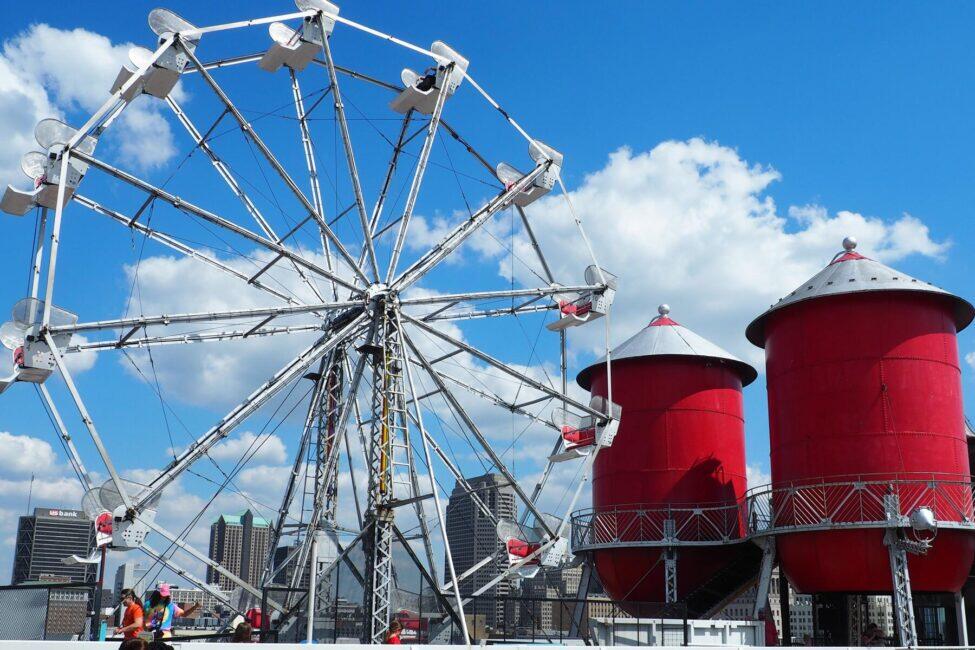It’s no secret St. Louis is passionate about its beer, baseball, and gorgeous Gateway Arch. But, there’s another attraction that is not as well known, a bit funky, but just as beloved.
For the past 25 years, the weird, wild, and wonderful City Museum has delighted kids of all ages, freaked out some nervous helicopter parents, and ignited millions of imaginations with its quirky, upcycled industrial exhibits. There are tunnels, treehouses, and caves abound in this former shoe warehouse turned ultimate urban playground. There are more than 30 slides, including two spiral versions that drop a breathtaking 10 stories. The entire 600-thousand-square-foot wacky wonderland is topped off by a school bus teetering precariously from the roof. Nearby, a 20-foot-tall metal praying mantis keeps a buggy eye on the street below, and guests can freely wander between the two.
Take equal parts carnival funhouse, add a dash of Beetlejuice landscape, and combine it with a tetanus shot waiting to happen. That’s the recipe for one of the most distinctive playscapes on Earth. Here’s everything you need to know about City Museum, the artistic mastermind who envisioned it, and what might be next for this St. Louis treasure.
Recommended Fodor’s Video
Reuse and Reimagining
No matter where you look, there’s something to discover at City Museum, usually crafted from concrete, rebar, or other discarded construction materials. The reuse and reimagining of those city leftovers are exactly what the museum’s founders first envisioned when they dreamed up this spectacular spot. Make no mistake, it was quite a dream.
In the 1990s, the area surrounding the massive International Shoe distribution center left much to be desired. The terrible condition of the warehouse was legendary.
“At that time, downtown was not a great area to be in, especially right by the museum,” chuckled Rick Erwin, City Museum’s creative director. “As the story goes, our doors were rusted shut from all the urine.”

Sculptor Bob Cassilly and his then-wife Gail looked past the neglect and saw pure potential. Bob was already well-known in St. Louis for restoring historic homes. He also created public art pieces featuring large, whimsical animals. In 1994, the Cassillys purchased the International Shoe warehouse and several surrounding buildings. Bob Cassilly served as artistic Pied Piper, bringing a group of hand-picked recruits along on the wild ride of renovating and revamping the massive space. They set out to acquire salvaged materials, and transform them into interactive works of art meant to be played with, climbed on, and touched.
It was the ultimate DIY project. The crew—engineers, sculptors, mosaic masters, and metalworkers–tackled one area at a time to build Cassilly’s one-of-a-kind playground.
“He wouldn’t make eye contact all the time,” recalls Erwin, an Art Institute of Chicago alum who’s worked at the museum since 2006. “He would just start staring at stuff, and that’s how you knew something was catching his attention, and a new vision was forming.”
Hundreds of bowling balls. Miles of tiles. Old wood flooring from a local high school. Construction cranes retired from worksites, train wheels, serving trays, and church organ pipes. Anything and everything the crew could get its collective hands on was incorporated into the imaginative build.
City Museum opened to a curious public in 1997. As visitors flocked to the quirky, whimsical spot, it didn’t take long for the area around it to rejuvenate and for the rest of the country to take notice. Buzz began to build. The museum started snapping up national awards and accolades, further solidifying its must-visit reputation.

A Quarter-Century of Evolution
Through the years, City Museum grew and evolved. Eccentric collections, ranging from objects found in outhouses to sand from beaches all over the world, went on display. New permanent features were added, including aquariums stocked with local but nippy fish and the rooftop terrace with its glorious terrors. Guests from around the globe flocked to the museum.
There was also a tragic transition at the top.
In the mid-2000s, Cassilly embarked on a new outdoor playground project he called Cementland. When he died in an accident there in 2011, City Museum’s staff found itself searching for the best way to carry on his vision.
“We were like, ‘How do we not screw this up?’” said Erwin.
The crew brought in a batch of consultants, including a cultural historian from Chicago, as well as a former professor of Cassilly’s. Their observations helped those left behind realize an essential truth about Cassilly’s work: materials dictate the build.
This became their guiding mantra moving forward.
“Every time we go to scrapyard, the vision’s there,” said Erwin. “You just bring it back. It’s fun to see what you can do, and how you can reuse these materials. And everybody loves to watch us work. They want to see what we’re doing, and where it’s going to go.”
In another sea-change, Premier Parks LLC bought City Museum in 2019. The group operates entertainment venues across the country. Erwin says the new owners helped the museum shore up various systems and operations while letting it stay true to its foundation.
“I reflected a lot about City Museum during the sale,” said Erwin. “This is a place where you can learn confidence. You remember the first time you ride a bike. Well, this is the first place you learn to go down a slide. If we have a school group, they’re all cheering for their teacher to come on down as well. I love it.”
It’s also the “a-ha moments” that keep Erwin centered and focused.
“Hopefully, some kid gets an idea here, goes home, and makes it happen,” he said. “Actually, I know they do–I get their letters all the time.”

The More Things Change…
City Museum is St. Louis’s own sort of Sagrada Familia, a fantastical masterpiece that’s never quite complete. The staff constantly shifts items, adds new exhibits, and offers different experiences for visitors of all ages.
But a few things remain constant:
Lost kids? They’ll turn up eventually. They always do—just ask Erwin. His did!
Spelunking the labyrinth of metal tunnels? Grab a pair of kneepads at the front desk.
Need a giggle? Find the world’s largest pair of underwear. It’s around somewhere, just like those lost kids.
Whimsical wonders like these are what’s kept the museum thriving for 25 years. The proof is in the numbers. According to its records, more than 13 million people have passed through the doors of the City Museum since 1997. Erwin says opportunities abound for the future, and he expects the sky will continue to be the limit.
Or maybe not. The museum’s eclectic rooftop might someday give the Arch a run for its money.
“I’ve always wanted to change that skyline,” said Erwin. “We’d love to just keep building up.”




